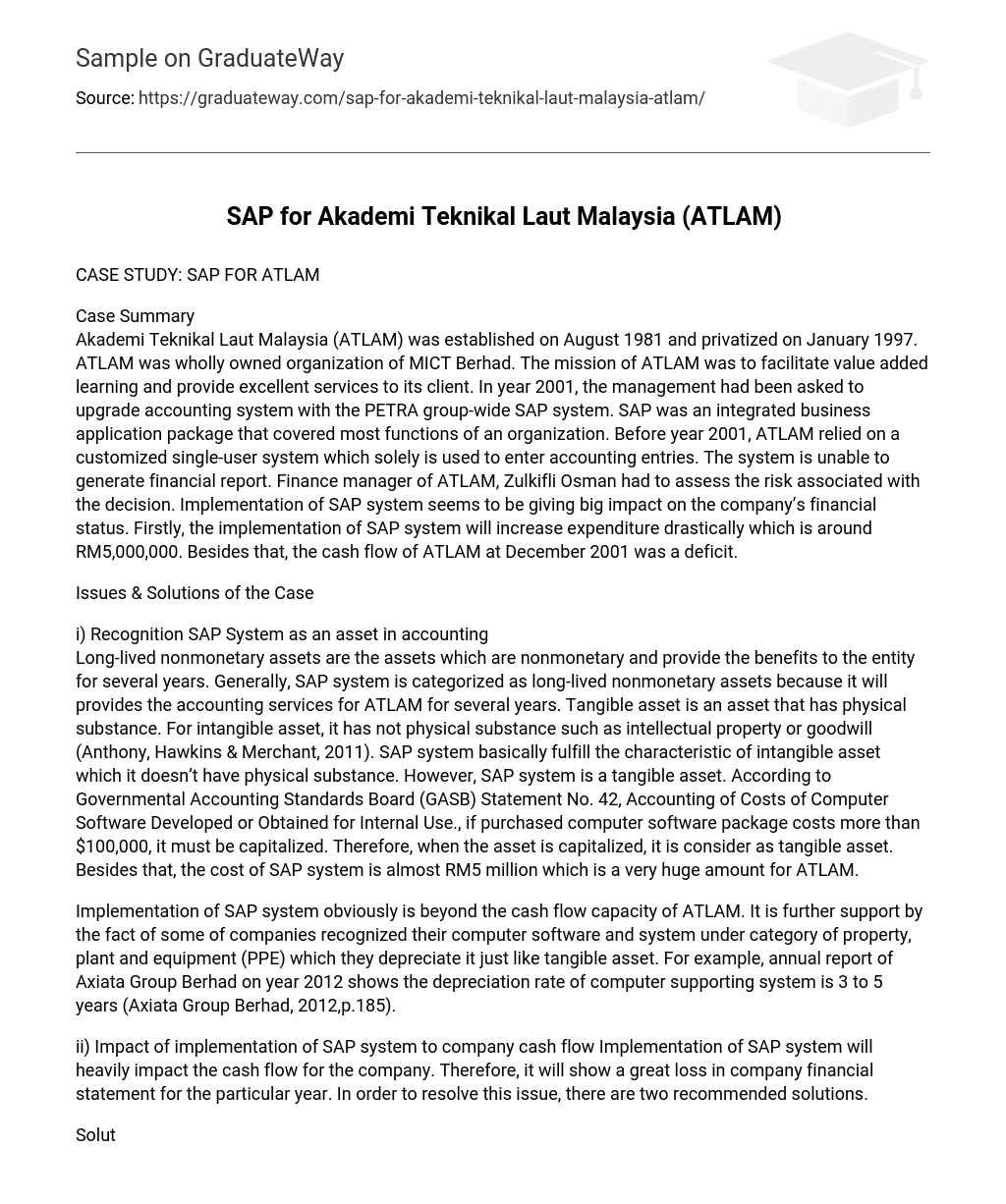Akademi Teknikal Laut Malaysia (ATLAM) was established in August 1981 and privatized in January 1997. It was under the ownership of MICT Berhad. ATLAM had a mission to provide excellent services and value-added learning to its clients. In 2001, they were asked to upgrade their accounting system to the PETRA group-wide SAP system. SAP is a comprehensive business application package that covers various organizational functions. Prior to 2001, ATLAM relied on a customized single-user system for accounting entries only, without the ability to generate financial reports. ATLAM’s Finance Manager, Zulkifli Osman, had to evaluate the associated risks of implementing the SAP system, as it had a significant impact on the company’s financial status. The implementation of SAP system incurred an estimated cost of approximately RM5,000,000 and atlAM had a deficit in its cash flow by the end of December 2001.
Long-lived nonmonetary assets are assets that provide benefits to an entity for multiple years and do not involve monetary value. The SAP system is considered a long-lived nonmonetary asset and provides accounting services to ATLAM over an extended period of time. Tangible assets have physical substance, while intangible assets consist of intellectual property or goodwill (Anthony, Hawkins & Merchant, 2011). The SAP system lacks physical substance and aligns with the characteristics of an intangible asset. However, it is also classified as a tangible asset according to Governmental Accounting Standards Board (GASB) Statement No. 42, which requires capitalization of computer software packages costing over $100,000. Therefore, when capitalized, the SAP system is treated as a tangible asset. Additionally, the cost of the SAP system for ATLAM is approximately RM5 million, representing a significant investment.
ATLAM does not have enough cash flow to implement the SAP system. This is evident from the fact that some companies treat computer software and systems as property, plant and equipment (PPE) and depreciate them like tangible assets. For example, Axiata Group Berhad’s annual report for 2012 mentions that their computer supporting system has a depreciation rate of 3 to 5 years (Axiata Group Berhad, 2012, p.185). Implementing the SAP system will significantly impact ATLAM’s cash flow and result in a substantial loss in their financial statement for that year. To address this issue, two recommended solutions are proposed.
The Finance Manager, Mr. Zulkifli Osman, might need to negotiate with the parent company, MICT Berhad, regarding the implementation of the SAP system in ATLAM. This is because the cost of the SAP system is excessively high. He may request MICT Berhad to fully subsidize ATLAM’s purchase of the entire system. Essentially, MICT Berhad would be responsible for purchasing and installing the system at ATLAM. If the management of MICT Berhad approves this decision, it could resolve the financial issue that ATLAM may face.
If MICT Berhad refuses to fully subsidize the ATLAM on the SAP system, Mr. Zulkifli Osman may negotiate with the Petra’s Group for a cheaper price. Since ATLAM cannot afford to pay a large initial cost, it is recommended that payment for the system be made in installments. Mr. Zulkifli Osman will need to work with the software provider to arrange monthly installment payments over a long period of time, reducing the cash flow burden for ATLAM. Additionally, an appropriate method of depreciation will be used to calculate depreciation expenses for the system.
The depreciation expenses for an asset are a fraction of the cost that is charged as expenses in each accounting period that the asset provides service to the entity (Anthony, Hawkins & Merchant, 2011). For this case study, the straight-line method is chosen to calculate the depreciation expenses because it is commonly used and simple. Some companies, like MAXIS, Affin Bank, and Air Asia, use the straight-line method to depreciate their assets, specifically software and computers. The accelerated method is not suitable because it significantly increases depreciation expenses compared to the straight-line method. The straight-line method evenly distributes depreciation expenses over the service life of the asset. Therefore, the straight-line method is more appropriate for calculating the depreciation expenses of the SAP system.
According to the case study, the cost of the SAP system is approximately RM5 million and its service life is assumed to be 5 years. This assumption is based on the common practice of many companies applying a similar service life to their computer and software systems. For instance, the annual report of Axiata Group Berhad and Green Packet Berhad for the year 2012 indicates a depreciation method of 3 to 5 years for their computer support systems (Green Packet Berhad, 2012, p. 79). Therefore, a depreciation rate of 20% per year will be applied. The calculation does not take into account any residual value as estimating the residual value proves difficult.





